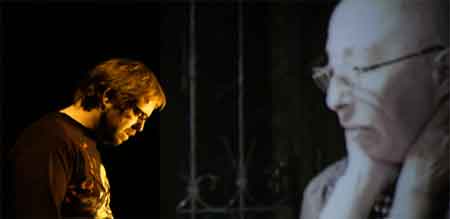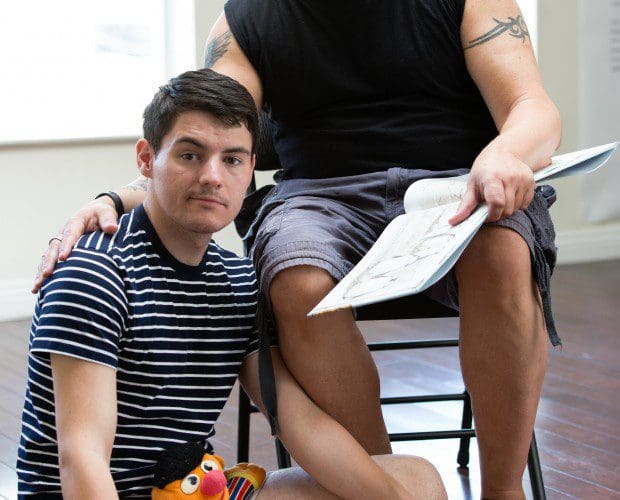 How to Disappear Completely was the second best thing I saw at SummerWorks this year (after Wild Dogs on the Moscow Trains). I loved it. It was everything I wished some of the other shows had been- personal, truthful, and funny without losing its sense of tragedy. Itai Erdal is the rare theatre creator able to tell his own story without being an actor (or, more impressive, a writer). He’s a lighting designer and, beyond writing and delivering the storytelling elements of his play with surprising ease and comic charm, he uses that skill to craft a metaphorical framework for the story of his mother’s death. The story alone, with its indelible character portraits and intriguing biculturalism, is beautiful but with his simple explanations of how stage lighting can affect a scene, Erdal elevates his piece to become not just compelling but uniquely so. He cuts to the essence of his characters (his family and closest friends) by describing how he would light them were they to appear with him on stage and uses a gradually fading and warming effect to, in the end, disappear completely from the stage. The metaphor of disappearance hits home startlingly with Erdal’s skill as both a technical designer and a storyteller lighting the densely dark stage.
How to Disappear Completely was the second best thing I saw at SummerWorks this year (after Wild Dogs on the Moscow Trains). I loved it. It was everything I wished some of the other shows had been- personal, truthful, and funny without losing its sense of tragedy. Itai Erdal is the rare theatre creator able to tell his own story without being an actor (or, more impressive, a writer). He’s a lighting designer and, beyond writing and delivering the storytelling elements of his play with surprising ease and comic charm, he uses that skill to craft a metaphorical framework for the story of his mother’s death. The story alone, with its indelible character portraits and intriguing biculturalism, is beautiful but with his simple explanations of how stage lighting can affect a scene, Erdal elevates his piece to become not just compelling but uniquely so. He cuts to the essence of his characters (his family and closest friends) by describing how he would light them were they to appear with him on stage and uses a gradually fading and warming effect to, in the end, disappear completely from the stage. The metaphor of disappearance hits home startlingly with Erdal’s skill as both a technical designer and a storyteller lighting the densely dark stage.
And now for my last show of the festival…
 I was a little wary of To Myself at 28. It felt, at least at first, like a somewhat self-indulgent bout of nostalgia. But then Spencer Charles Smith broke character as Sky Gilbert at 28 and became the actor Gilbert hired to play the part, chastising the playwright for his self-indulgence. Gilbert’s play is certainly a bit of of self-centered pondering, but its layers of meta-theatricality make it interesting enough to overcome the predictability of its personal conclusions. Gilbert and Smith play off each other wonderfully, the best part of the play being when Smith drops even his actor character and is just himself for a moment, pondering how his role as Gilbert’s protégé will come to define him. It’s that mentor-protégé relationship that is To Myself at 28’s most intriguing quality. Gilbert’s play is a little bit about himself a long time ago but a lot about Smith right now. It takes a little naval-gazing meandering to get to the heart of the play’s matter and, when we finally do get there, it’s not as deeply explored as I would have liked but the idea is there and it’s certainly worth the exploration.
I was a little wary of To Myself at 28. It felt, at least at first, like a somewhat self-indulgent bout of nostalgia. But then Spencer Charles Smith broke character as Sky Gilbert at 28 and became the actor Gilbert hired to play the part, chastising the playwright for his self-indulgence. Gilbert’s play is certainly a bit of of self-centered pondering, but its layers of meta-theatricality make it interesting enough to overcome the predictability of its personal conclusions. Gilbert and Smith play off each other wonderfully, the best part of the play being when Smith drops even his actor character and is just himself for a moment, pondering how his role as Gilbert’s protégé will come to define him. It’s that mentor-protégé relationship that is To Myself at 28’s most intriguing quality. Gilbert’s play is a little bit about himself a long time ago but a lot about Smith right now. It takes a little naval-gazing meandering to get to the heart of the play’s matter and, when we finally do get there, it’s not as deeply explored as I would have liked but the idea is there and it’s certainly worth the exploration.
One Last Note:
This year’s SummerWorks Festival was really pretty excellent. I saw a lot of great stuff, the schedule was easy to navigate, the venues were managed expertly, the staff was close to universally helpful and friendly. Even the Performance Bar was an improvement on last year with its “Art Court” theme and clever, sardonic hosts Kayla Lorette and Alex Tindal (whose improv was laugh-out-loud funny even if the acts they hosted were sometimes less than fantastic). But perhaps the best addition to this year’s festival was the courtyard bar at the Lower Ossington hub. Likely inspired by Fringe’s famous beer tent, SummerWorks’s ace admin team took it upon themselves to create a similar space for revelers of their own festival. Making use of a very unpredictable space at the back of the LOT, the courtyard bar was simple but well-run and pretty despite its rustic digs (I think it was a garage + parking lot kind of deal). It played host to the rowdily fun closing party (Only Major Point Against Them: Artistic Producer Michael Rubenfeld once again rambled unappealingly, withholding the spotlight from the award winners he was supposed to be announcing) but also created a space that could serve as a headquarters for dedicated theatre-goers caught between shows at the festival’s well-chosen smattering of theatres both easier to access and closer together than the typical Fringe spaces. The perfect marriage of thoughtful curation with sharp administration, SummerWorks 2013 really worked.
